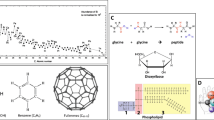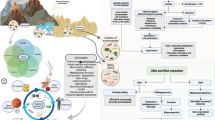Abstract
A mathematical model of the active transport of main ions in cells of archaebacteria has been constructed. A set of equations has been developed and solved for ion fluxes through the bacterium membrane. The model is based on the principle “one ion—one transport system.” Considering experimental data, the major transport mechanism was determined for each ion and the balance equation was written on the basis of this mechanism in the stationary state. This allowed calculating values of the membrane potential and intracellular concentrations of the ions independently. The calculated values of the intracellular concentrations and resting potential are in qualitative agreement with the corresponding experimental values for cells of extremely halophilic archaea.
Similar content being viewed by others
References
Alcamo, I.E., 2001. Fundamentals of Microbiology, 6th edn. Benjamin Cumming, Menlo Park.
Bakker, E.P., Rottenberg, H., Caplan, S.R., 1976. An estimation of the light-induced electrochemical potential difference of protons across the membrane of Halobacterium halobium. Biochim. Biophys. Acta 440, 557–572.
Bara, M., Guiet-Bara, A., Durlach, J., 1993. Regulation of sodium and potassium pathways by magnesium in cell membranes. Magnes. Res. 6, 167–177.
Bogomolni, R.A., 1977. Light energy conservation processes in Halobacterium halobium cells. Fed. Proc. Fed. Am. Soc. Exp. Biol. 36, 1833–1839.
Borrelly, G., Boyer, J.C., Touraine, B., 2001. The yeast mutant vps5 affected in the recycling of Golgi membrane proteins displays an enhanced vacuolar Mg2+/H+ exchange activity. Proc. Natl. Acad. Sci. U.S.A. 98, 9660–9665.
Detkova, E.N., Pusheva, M.A., 2006. Energy metabolism in halophilic and alkaliphilic acetogenic bacteria. Microbiology 75(1), 5–17.
Goldman, D.E., 1943. Potential, impedance, and rectification in membrane. J. Gen. Physiol. 27, 37–60.
Hodgkin, A.L., Katz, B., 1949. The effect on sodium ions in electrical activity of the giant axon of the squid. J. Physiol. (Lond.) 108, 37–77.
Kjelstrup, S., Rubi, J.M., Bedeaux, D., 2005. Active transport: a kinetic description based on thermodynamic grounds. J. Theor. Biol. 234, 7–12.
Lanyi, J.K., 1978. Light energy conversion in Halobacterium halobium. Microbiol. Rev. 42(4), 682–706.
Lengeler, J., Drews, G., Schlegel, H., 1999. Biology of the Prokatyotes, Blackwell, Oxford.
Melkikh, A.V., Seleznev, V.D., 2005. Models of active transport of ions in biomembranes of various types of cells. J. Theor. Biol. 234(3), 403–412.
Melkikh, A.V., Seleznev, V.D., 2006a. Requirements on models and models of active transport of ions in biomembranes. Bull. Math. Biol. 68(2), 385–399.
Melkikh, A.V., Seleznev, V.D., 2006b. Model of active transport of ions in biomembranes on ATP-dependent change of height of diffusion barriers to ions. J. Theor. Biol. 242(3), 617–626.
Melkikh, A.V., Seleznev, V.D., 2007. Models of active transport of neurotransmitters in synaptic vesicles. J. Theor. Biol. 248(2), 350–353.
Michel, H., Oesterhelt, D., 1976. Light-induced changes of the gradient and the membrane potential in H. halobium. FEBS. Lett. 65, 175–178.
Ng, W.V., Kennedy, S.P., Mahairas, G.G., Berquist, B., Pan, M., Shukla, H.D., Lasky, S.R., Baliga, N.S., Thorsson, V., Sbronga, J., Swartzell, S., Weir, D., Hall, J., Dahl, T.A., Welti, R., Goo, Y.A., Leithauser, B., Keller, K., Cruz, R., Danson, R.J., Hough, D.W., Maddocks, D.G., Jablonski, P.E., Krebs, M.P., Angevine, C.M., Dale, H., Isenbarger, T.A., Peck, R.F., Pochlschroder, M., Spudich, J.L., Jung, K.-H., Alam, M., Freitas, T., Hou, S., Daniels, C.J., Dennis, P.P., Omer, A.D., Ebhardt, H., Lowe, T.M., Liang, P., Riley, M., Hood, L., DasSarma, S., 2000. Genome sequence of Halobacterium species NRC-1. Proc. Natl. Acad. Sci. U.S.A. 97(22), 12176–12181.
Oren, A., 1999. Bioenergetic aspects of halophilism. Microbiol. Mol. Biol. Rev. 63, 334–348.
Schafer, G., Engelhard, M., Muller, V., 1999. Bioenergetics of the archaea. Microbiol. Mol. Biol. Rev. 63(3), 570–620.
Smirnov, A.V., Suzina, N.E., Kulakovskaya, T.V., Kulaev, I.S., 2002. Magnesium orthophosphate, a new form of reserve phosphate in the halophilic archaeon Halobacterium salinarium. Microbiology 71(6), 786–793.
Tortora, G.J., Funke, B.R., Case, C.L., 2003. Microbiology: An Introduction, 8th edn. Benjamin–Cummings, Redwood City, 827 p.
Wagner, C.A., Finberg, K.E., Breton, S., Marshansky, V., Brown, D., Geibel, J., 2004. Renal vacuolar H+-ATPase. Physiol. Rev. 84, 1263–1314.
Author information
Authors and Affiliations
Corresponding author
Rights and permissions
About this article
Cite this article
Melkikh, A.V., Seleznev, V.D. Model of Active Transport of Ions in Archaea Cells. Bull. Math. Biol. 71, 383–398 (2009). https://doi.org/10.1007/s11538-008-9366-6
Received:
Accepted:
Published:
Issue Date:
DOI: https://doi.org/10.1007/s11538-008-9366-6




